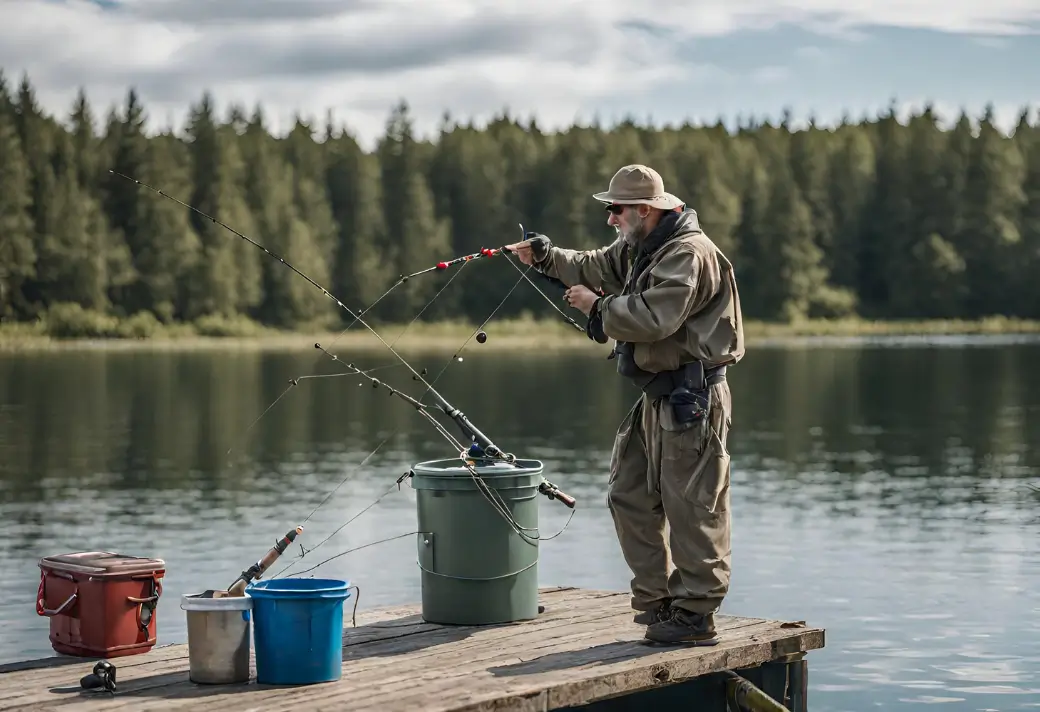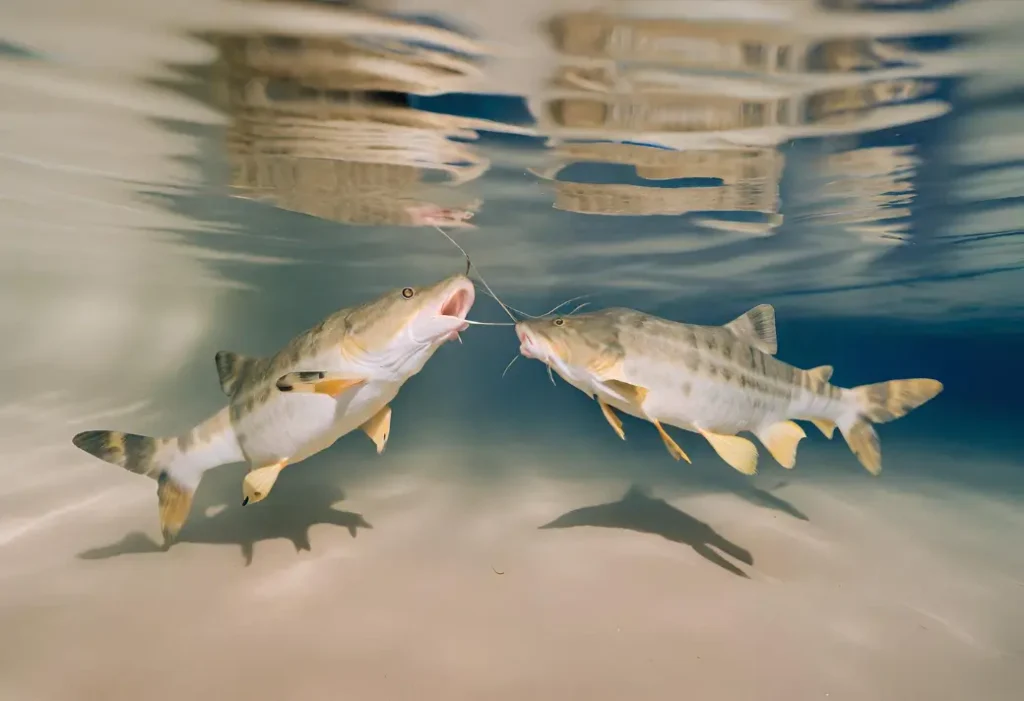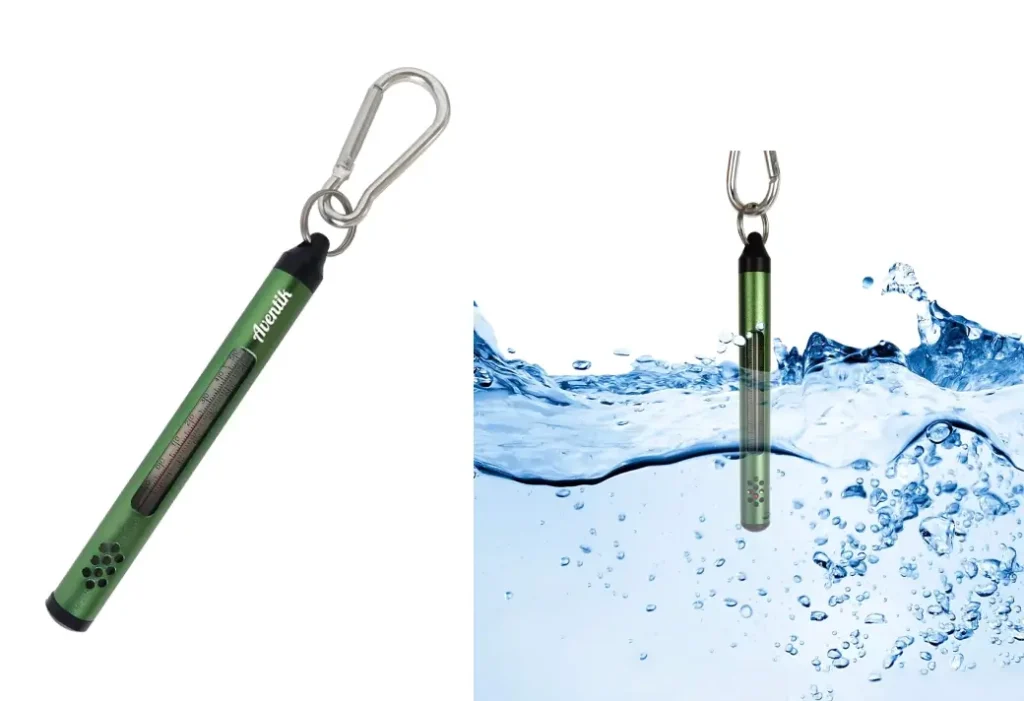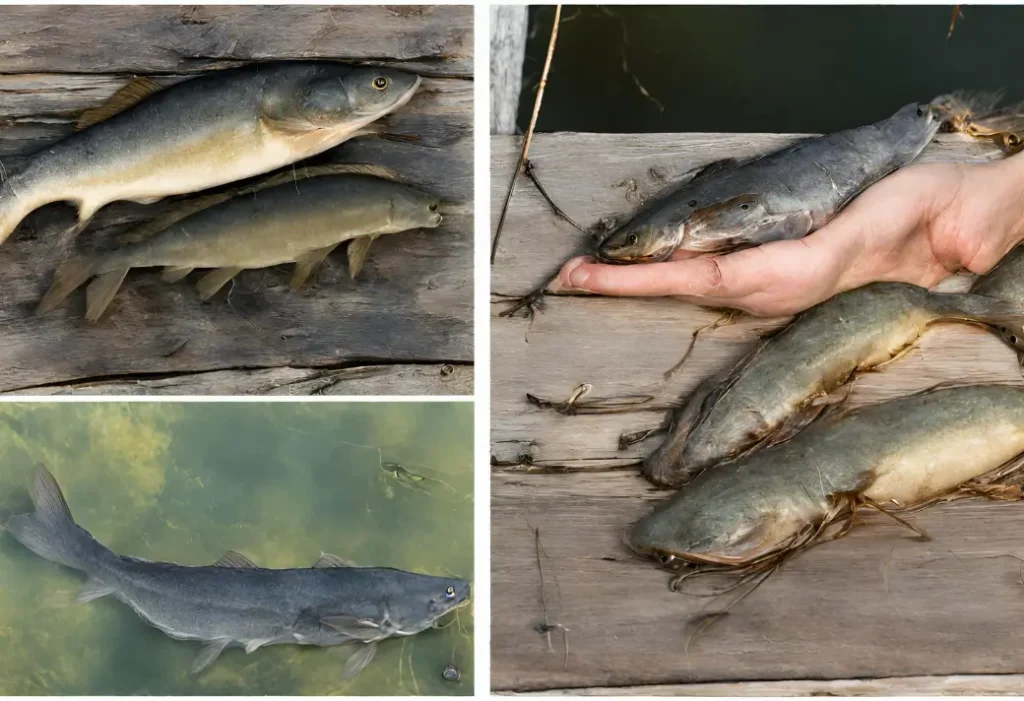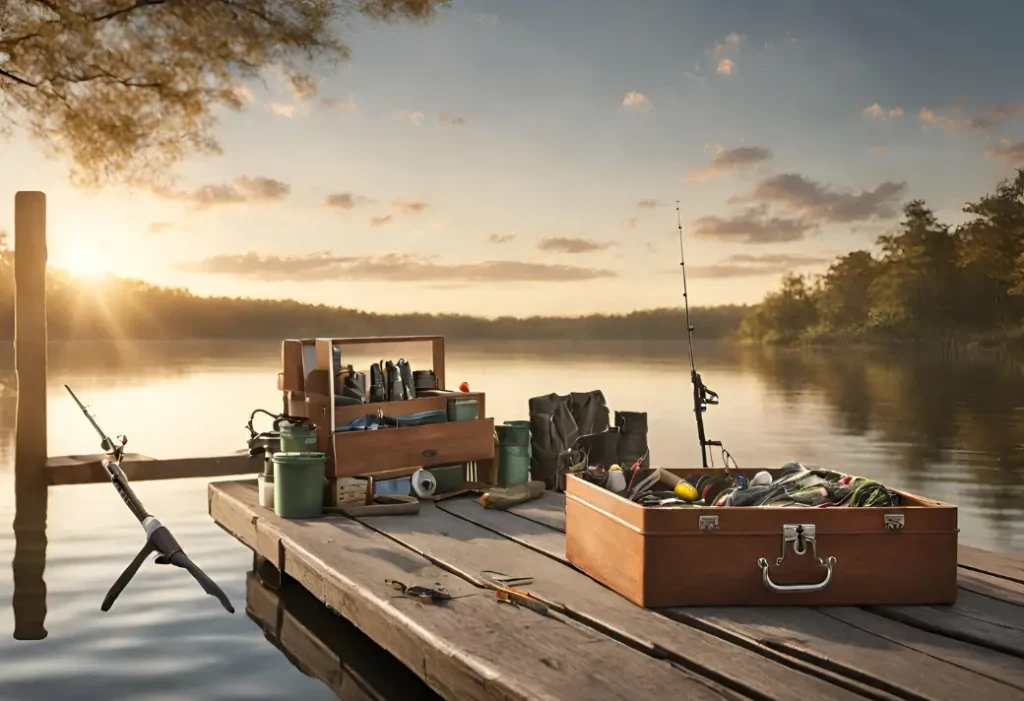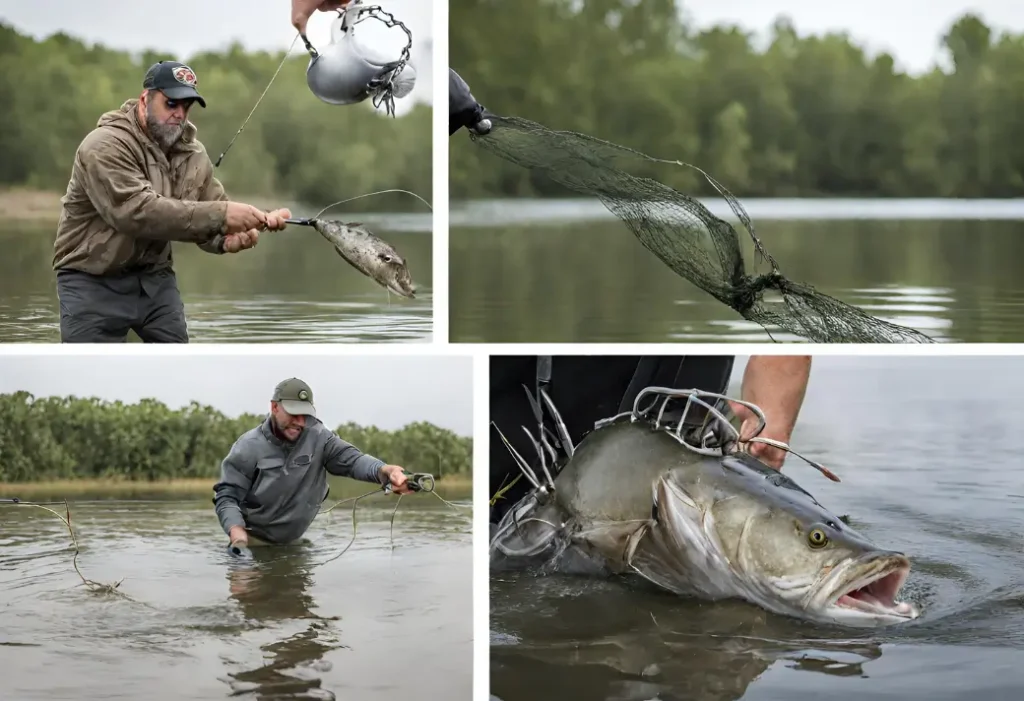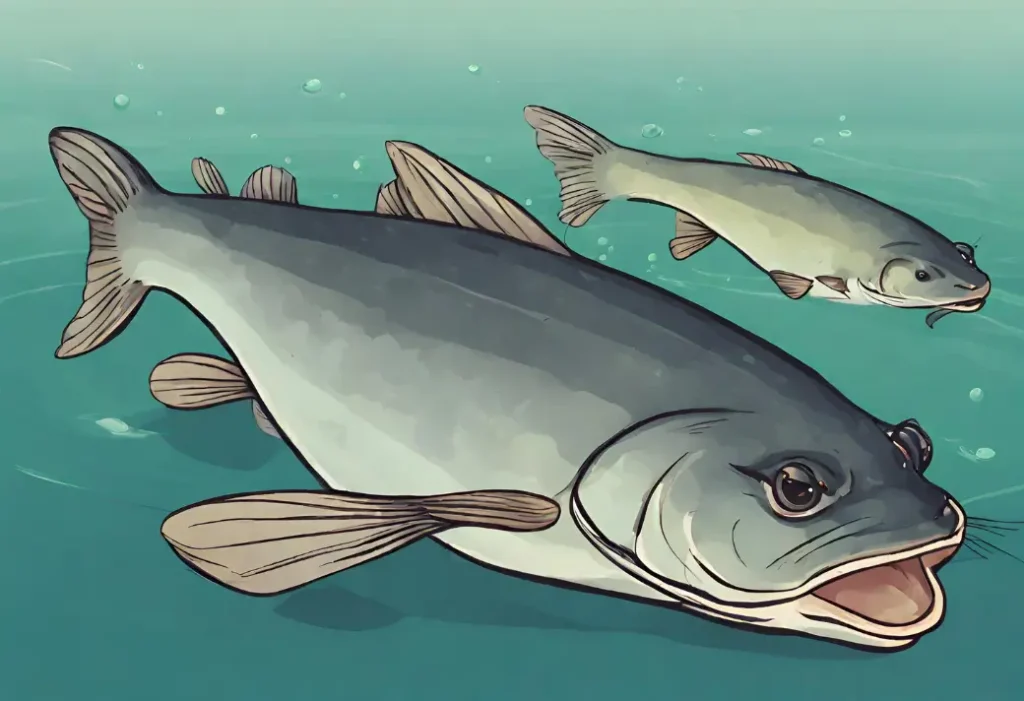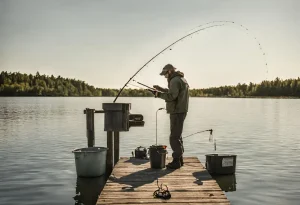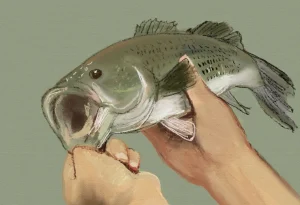Lake fishing for catfish is an exciting and rewarding experience for anglers of all skill levels. Whether you are a beginner or an experienced angler, there is always something new to learn and discover in the world of catfish fishing.
In this article, I will guide you through the process of lake fishing for catfish, from identifying different species to finding the perfect spots and using irresistible bait. I will also share techniques for hooking, fighting, and landing trophy catfish. So, grab your fishing gear and get ready to embark on an adventure!
Different Species of Catfish Found in Lakes
Before we dive into the art of lake fishing for catfish, it’s important to familiarize yourself with the different species you may encounter. The most common species found in lakes include the channel catfish, blue catfish, and flathead catfish. Each species has its own unique characteristics and preferred habitat. The channel catfish, for example, is known for its sharp spines and olive-brown coloration. The blue catfish, on the other hand, is larger in size and has a bluish-gray coloration. The flathead catfish is distinguishable by its flat head and mottled brown coloration. By understanding the different species, you can tailor your fishing techniques and strategies accordingly.
Unveiling the Big Three: Channel, Blue, and Flathead Catfish
Lake fishing for catfish offers an exciting challenge, and knowing your target is key to success. Here, we’ll shine a light on the three most sought-after catfish species lurking in the depths: channel, blue, and flathead catfish.
Channel Catfish:
The spunky champion. Easily recognized by their forked tails and olive-brown bodies with darker spots, channel catfish are the most common lake dwellers. They put up a spirited fight, making them a favorite among anglers.
Blue Catfish:
The gentle giant. These behemoths can reach impressive sizes, with a bluish-gray hue and a forked tail similar to channel catfish. Blue catfish are powerful swimmers but tend to fight less aggressively than their channel cousins.
Flathead Catfish:
The master of ambush. Distinguished by their broad, flat heads and mottled brown bodies, flatheads are ambush predators. They lie in wait for prey near structure and pack a surprising punch when hooked.
Channel Catfish: The Spikey Fighter
Channel catfish are the undisputed champions of spunk in the lake. These feisty fish are readily identifiable by their:
- Forked tail: This distinctive feature sets them apart from other catfish species.
- Olive-brown body: Often adorned with darker spots, their coloration provides excellent camouflage in their lake habitat.
- Barbels: Like all catfish, channel catfish have long whiskers called barbels, which help them navigate murky waters and locate food.
- Sharp pectoral and dorsal fins: These fins contain a protective spine that can inflict a painful sting, so handle with care!
Beyond their appearance, channel catfish are known for their:
- Scrappy fighting spirit: They will put up a determined battle when hooked, making them a thrilling catch for anglers of all experience levels.
- Omnivorous feeding habits: They readily devour live bait like nightcrawlers and minnows, as well as prepared baits like catfish dough balls and chicken livers.
- Social tendencies: Channel catfish often travel in schools, increasing your chances of landing multiple fish in a single outing.
Understanding these characteristics will put you on the right track to successfully targeting channel catfish in your next lake fishing adventure.
Blue Catfish: The Gentle Giant
Lurking in the depths of many lakes resides a true giant – the blue catfish. These magnificent fish are known for their impressive size and unique characteristics:
- Size matters: Blue catfish are the heavyweight champions of the lake, regularly reaching lengths exceeding three feet and tipping the scales at over 100 pounds. Their potential for trophy catches makes them a dream for many anglers.
- Subtle coloration: Unlike their channel catfish cousins, blue catfish have a sleek, bluish-gray body that provides camouflage in deeper waters.
- Forked tail: Similar to channel catfish, they possess a deeply forked tail that propels them through the water with powerful bursts of speed.
While large, blue catfish are surprisingly:
- Relatively docile: Compared to the feisty channel catfish, blue catfish tend to fight less aggressively when hooked. However, their immense size can still provide a thrilling battle.
- Powerful swimmers: Don’t underestimate their strength! Blue catfish can easily overpower unprepared anglers, so be sure to use sturdy equipment.
- Opportunistic feeders: They have a varied diet that includes fish, mussels, crayfish, and even carrion. This makes them adaptable to different bait choices.
Knowing these traits will help you prepare for the unique challenge of catching a blue catfish. Remember, these gentle giants deserve respect and proper handling due to their size and potential for age.
Flathead Catfish: The Master of Ambush
In the shadowy depths of lakes lurks a predator unlike any other – the flathead catfish. This cunning fish is a master of ambush, perfectly adapted to strike fear into the hearts of prey and anglers alike.
Distinctive Features:
- Flattened head: Their namesake feature, the broad, flat head allows them to blend seamlessly with the lake bottom.
- Mottled brown body: Flatheads are masters of camouflage, with a mottled brown coloration that breaks up their outline and makes them nearly invisible.
- Underbite: Their lower jaw juts out prominently, giving them a menacing appearance.
Predatory Prowess:
- Lie in wait: Unlike their actively foraging catfish cousins, flatheads prefer to ambush prey. They lie in wait near structure like sunken logs and rocks, ready to strike unsuspecting fish.
- Powerful strike: Their large mouths and sharp teeth allow them to overpower even sizeable prey with lightning speed.
- Solitary hunters: Flatheads are loners, and their territories can encompass vast areas of the lake bottom.
Challenge Accepted:
- Tenacious fighters: Once hooked, flatheads put up a fierce fight, using their powerful bodies and dogged determination to escape. Be prepared for a battle of wills!
- Strong tackle required: Their size and strength demand robust fishing gear. Heavy rods, reels, and lines are essential for landing a trophy flathead.
- Strategic targeting: Understanding their preferred habitat and predatory behavior is key to successfully targeting these elusive fish.
Flathead catfish are a formidable quarry for experienced anglers. Their impressive size, cunning tactics, and fighting spirit make them the ultimate test of skill and patience on the lake.
Beyond the Big Three: Other Catfish Species You Might Encounter
While channel, blue, and flathead catfish steal the spotlight, there’s a fascinating diversity of catfish species that call lakes home. Here are a few you might encounter depending on your location:
- Black Bullhead Catfish: These stocky fighters are known for their large heads and dark brown or black bodies. They favor shallow, weedy areas and readily take live bait.
- Yellow Bullhead Catfish: Similar to black bullheads, but with a lighter yellow or brown coloration. They inhabit similar areas and offer a fun challenge for anglers of all skill levels.
- White Catfish: Also known as “spoons,” these sleek catfish have a silvery body and a slender build. They prefer deeper waters and tend to be smaller than their catfish cousins.
- Spotted Catfish: These beautifully marked catfish have a yellow body adorned with black spots. They are bottom feeders and can be targeted using live bait or nightcrawlers.
Remember, these are just a few examples. Local regulations and specific lake ecosystems may harbor other unique catfish species. Researching the local catfish populations can add another layer of excitement to your lake fishing adventure!
Identifying the Perfect Spots for Catfish
When it comes to lake fishing for catfish, location is key. Catfish are bottom-dwelling fish that prefer deep, slow-moving waters with plenty of cover, such as fallen trees, rocks, and underwater vegetation. Look for areas with submerged structures where catfish can hide and ambush their prey. In addition, pay attention to water temperature and oxygen levels, as catfish are sensitive to these factors. Look for areas with cooler water temperatures and higher oxygen levels, as these conditions are more favorable for catfish. Some popular spots to target include creek channels, deep holes, and points where two bodies of water meet.
Understanding Catfish Habitat:
Catfish aren’t just any fish. They’re masters of the lake bottom, spending most of their time lurking in the depths. To attract these cunning creatures, you need to understand their preferred environment.
Bottom Dwellers by Nature:
- Catfish lack swim bladders, an air-filled organ that helps most fish stay buoyant. This makes them naturally drawn to the lake floor, where they can rest, feed, and avoid predators.
Seeking Shelter and Security:
- Catfish are ambush predators, relying on cover to strike unsuspecting prey. They favor areas with structure and clutter, such as:
- Sunken logs and brush piles: These provide hiding spots and breeding grounds.
- Rock piles and ledges: Offer crevices and shade, perfect for ambushing prey.
- Weed beds and vegetation: Create a labyrinthine environment for catfish to navigate and find food.
Understanding their Preference is Key:
By pinpointing areas with these features, you significantly increase your chances of encountering catfish. They feel secure and have easy access to food sources in these structured environments. So, the next time you’re at the lake, keep your eyes peeled for these catfish havens!
Seeking Structure and Cover:
Catfish are masters of using their environment to their advantage. When searching for these whiskered wonders, focus on areas that provide both structure and cover:
Sunken Trees and Brush Piles:
- Imagine an underwater apartment complex. Sunken trees offer catfish a place to hide, spawn, and ambush prey. The tangled branches and debris create a labyrinth that catfish love to explore.
Rock Piles and Ledges:
- Rocky areas are like natural breakwaters, attracting baitfish and offering catfish a cool, oxygen-rich environment. Look for crevices and ledges where catfish can lie in wait for their next meal.
Weed Beds and Vegetation:
- Lush weed beds are like underwater jungles. They provide catfish with ample food sources, like insects and small fish, and offer protection from predators. Catfish navigate these intricate structures with ease, making them a prime target location.
Man-Made Structures:
- Don’t forget about human-made features like docks, bridges, and old dams. These structures can create habitat similar to natural cover, attracting catfish and offering potential ambush points.
Remember: The more complex the structure and the more diverse the cover, the better. These areas create a smorgasbord for catfish and provide them with a sense of security. So, the next time you’re out on the lake, keep an eye out for these underwater hotspots!
Water Conditions: Temperature and Oxygen:
Catfish aren’t just about the right habitat; water quality plays a vital role in their survival and activity. Here’s why temperature and oxygen levels are crucial factors to consider:
Temperature:
Catfish are cold-blooded creatures, meaning their body temperature adjusts to the surrounding water. They thrive in specific temperature ranges:
- Optimal range: Generally between 70-80°F (21-27°C). This is when they are most active and feed readily.
- Tolerance: Catfish can survive in a wider range, from around 50°F (10°C) to over 85°F (29°C). However, their metabolism slows down in extreme temperatures, making them less active feeders.
Identifying Favorable Temperatures:
- Seasonal variations: Catfish tend to move deeper in colder months and shallower in warmer months.
- Thermoclines: In summer, lakes may have a distinct layer separation. Look for areas below the thermocline (where water is cooler) for catfish activity.
Oxygen Levels:
Just like any other living thing, catfish need oxygen to survive. Low oxygen levels can stress them and limit their activity.
- Ideal range: Dissolved oxygen levels above 5 mg/L are considered optimal for catfish.
- Low oxygen zones: Avoid areas with stagnant water or excessive algae blooms, as these can deplete oxygen levels.
Tips for Finding Oxygen-Rich Zones:
- Moving water: Look for areas with current or near waterfalls, where oxygen is naturally replenished.
- Windy conditions: Wind helps circulate water and increase oxygen levels at the surface.
By understanding these factors and using tools like thermometers and dissolved oxygen meters, you can significantly increase your chances of finding catfish in healthy and active states. Remember, happy catfish mean more bites for you!
Prime Catfish Locations:
Now that you understand catfish preferences, let’s explore specific areas in lakes where they’re likely to be lurking:
- Creek Channels: These underwater highways are natural feeding grounds for catfish. Creek channels often have deeper water, moving currents, and structure like rocks and logs, creating a perfect catfish haven.
- Deep Holes: Catfish are drawn to the cooler, deeper parts of lakes. Look for areas with significant depth changes, like underwater craters or old riverbeds. These holes provide catfish with a cool retreat and a place to ambush prey.
- Points and Ledges: Where land juts out into the lake, creating points and ledges, catfish find an abundance of food and隠れ家. The transition zones between shallow and deep water offer catfish easy access to prey and a place to lay in wait.
- Underwater Drop-offs: Similar to points and ledges, drop-offs create changes in depth and often harbor structure like rocks and vegetation. These areas offer catfish easy access to both deep and shallow water, making them prime feeding locations.
- Other Catfish Magnets: Don’t forget about man-made structures like sunken bridges, old dam sites, and flooded timber. These areas mimic natural catfish habitat and can hold surprising numbers of whiskered residents.
Remember: These are just starting points. Observing the lake itself can reveal hidden gems. Look for areas with current breaks, inflows from streams, or unusual bottom features. These can be hotspots for catfish activity.
Pro Tip: Utilizing a depth finder can be a game-changer. It allows you to visualize underwater structures, locate drop-offs, and pinpoint promising fishing spots.
Utilizing Technology for Spot Selection:
While understanding catfish behavior is key, technology can give you a significant edge in locating prime fishing spots. Here’s how:
- Depth Finders: These are your underwater eyes, revealing the hidden world beneath the surface. Look for features like:
- Structure: Identify sunken logs, rock piles, and weed beds that catfish love.
- Depth Changes: Locate creek channels, deep holes, and drop-offs where catfish tend to congregate.
- Bottom Hardness: Distinguish between soft mud and hard bottoms, which catfish often prefer.
- Lake Maps: Many lakes have detailed maps available online or in fishing stores. These maps can show:
- Bathymetry: Contour lines indicating underwater depth and potential drop-offs.
- Structures: Marked locations of sunken brush piles, docks, and other man-made features.
- Fishing Points of Interest: Areas known for catfish activity based on user reports or local knowledge.
Remember: Technology is a powerful tool, but it shouldn’t replace your understanding of catfish behavior. Use these resources to supplement your knowledge and refine your search for the perfect catfish hotspots. Tight lines!
Understanding the Behavior and Feeding Habits of Catfish
To increase your chances of success in lake fishing for catfish, it’s important to understand their behavior and feeding habits. Catfish are opportunistic feeders and will eat almost anything that comes their way. They primarily feed on live bait, such as worms, minnows, and crayfish, but they will also go for dead bait, such as cut bait or stink bait. Catfish are more active during dusk and dawn, so it’s best to plan your fishing trips accordingly. They are also more active during warmer months, as their metabolism increases with rising water temperatures. By understanding their behavior and feeding habits, you can choose the right bait and fishing techniques to attract catfish.
Unveiling the Opportunistic Eater: Catfish Feeding Habits
Catfish aren’t picky eaters. They’ve earned the nickname “bottom feeders” for a reason – they’re constantly scavenging the depths for their next meal. Understanding their diverse diet is key to tempting them with your bait.
A Menu Full of Options:
- Live Bait: Fresh offerings like worms, minnows, crayfish, and insects are irresistible to catfish. Their wiggling movements and natural scents trigger the catfish’s predatory instincts.
- Dead Bait: Don’t underestimate the power of cut bait (pieces of fresh fish) or stink bait (specially cured concoctions). The strong smells and decaying flesh attract catfish from afar.
- Natural Scavengers: Catfish won’t hesitate to consume aquatic plants, fruits, nuts, and even carrion. They’re efficient cleaners of the underwater world.
Understanding Their Preferences:
- Species Specific: While the basics apply to most catfish, some species have particular favorites. Channel catfish love nightcrawlers, while blue catfish might prefer larger prey like small fish. Researching the specific catfish you’re targeting can give you an edge.
- Freshness Matters: Live bait is generally more enticing, but properly prepared dead bait can be just as effective. Experiment and see what works best in your local waters.
Remember: Catfish use their whiskers to taste and smell their food. Strong scents and wiggling movements are often the key to unlocking their feeding frenzy.
When the Bite is Hot: Peak Activity Periods of Catfish
Catfish aren’t constantly on the prowl. Understanding when their feeding activity peaks can significantly increase your chances of success. Here’s how some key factors influence their behavior:
Time of Day:
- Dusk and Dawn: These periods offer low light conditions, which catfish prefer for feeding. They become more active as the sun dips below the horizon and remain so until the day breaks.
- Nighttime: During the darkest hours, catfish rely heavily on their whiskers and keen sense of smell to locate food. This can be a prime time for targeted fishing, especially in warmer months.
Water Temperature:
- Warmer Months: As water temperatures rise, catfish become more active and their metabolism increases. This generally translates to a higher feeding drive.
- Cooler Months: In colder water, catfish tend to be less active and feed less frequently. However, they can still be targeted with the right bait and techniques.
Seasonal Shifts:
- Spring and Fall: These transitional seasons often see increased catfish activity as water temperatures fluctuate and baitfish become more abundant.
- Summer: The peak feeding period for most catfish species occurs during the warm summer months.
Keeping these factors in mind:
- Plan your fishing trips around peak activity times. Early mornings, evenings, and even night fishing can be particularly productive.
- Adjust your bait selection based on water temperature. Live bait might be more effective in warmer months, while stink baits can entice catfish in cooler water.
By understanding these patterns, you can be at the right place, at the right time, with the right bait to tempt even the most sluggish catfish.
Choosing the Right Bait: Matching the Catfish’s Menu
Catfish may be opportunistic eaters, but understanding their preferences can significantly improve your catch rate. Here are some tips to choose the right bait and match the catfish’s menu:
Consider the Catfish Species:
- Channel catfish: These versatile feeders favor live bait like nightcrawlers, minnows, and crayfish. They also respond well to cut bait and prepared dough balls.
- Blue catfish: These larger catfish might require bigger offerings. Live shad, large minnows, or even cut bait chunks can be effective.
- Flathead catfish: Known for their aggressive nature, flatheads readily attack live bait like sunfish, large frogs, or even small bluegill.
Live vs. Dead Bait:
- Live bait: Often the most enticing option, offering movement and natural scents. Nightcrawlers, minnows, and crayfish are popular choices.
- Dead bait: More affordable and convenient, but requires proper selection and preparation. Cut bait (fresh fish chunks) and stink baits (specially cured concoctions) can be effective.
Matching the Bait to the Season:
- Warmer months: Live bait like worms and minnows often work best, as catfish are more active and their metabolism is high.
- Cooler months: Consider using stronger scents like stink baits or prepared dough balls, as catfish become less active and rely more on their sense of smell.
Freshness Matters:
- Always use the freshest bait possible, especially for live bait. Sluggish or unhealthy bait will be less attractive to catfish.
- For dead bait, choose options with a strong scent and firm texture. Avoid mushy or discolored bait.
Beyond the Basics:
- Experiment with different bait combinations: Combining live and dead bait, or adding attractants like cheese or scents, can sometimes increase your success.
- Observe local practices: Talk to experienced anglers in your area to learn what bait works best for the specific catfish species and water body you’re targeting.
Remember, choosing the right bait is just one piece of the puzzle. By combining this knowledge with your understanding of catfish behavior and habitat, you’ll be well on your way to unlocking the secrets of successful catfishing.
Beyond the Bait: Additional Factors Affecting Catfish Behavior
While bait selection is crucial, other factors can influence catfish behavior and impact your fishing success. Here are a few to keep in mind:
- Water Clarity: Catfish primarily rely on their sense of smell and taste to locate food, especially in murky or low-light conditions. Strong-smelling baits like stink baits or prepared dough balls can be more effective in such scenarios. Conversely, in clearer water, catfish might be more cautious and respond better to subtler presentations of live bait or natural-looking lures.
- Presence of Cover: As mentioned earlier, catfish are drawn to areas with structure and cover, like sunken logs, rocks, and weed beds. These features provide them with a sense of security and make them feel less vulnerable. Targeting areas with ample cover increases your chances of encountering catfish, even if your bait presentation isn’t perfect.
- Noise and Movement: Catfish have a keen sense of hearing and can be spooked by excessive noise or sudden movements. Practice stealthy approaches and avoid making loud noises around your fishing spot. Additionally, using subtle presentations and minimizing movement of your bait can help keep catfish from getting spooked.
By understanding these additional factors, you can go beyond simply offering the right bait and create a more holistic approach to attracting and catching catfish. Remember, successful fishing often involves a combination of various tactics, and considering these subtle influences can significantly improve your chances of landing that trophy catfish.
Essential Gear and Equipment for Lake Fishing
To embark on a successful lake fishing trip for catfish, you will need the right gear and equipment. A sturdy fishing rod and reel combo with a strong line is essential for handling the powerful strikes of catfish. Choose a medium to heavy action rod with a high-quality reel that can handle the weight and strength of catfish. In addition, invest in a variety of hooks and sinkers to accommodate different fishing conditions. A landing net and a pair of fishing gloves are also useful to handle catfish safely. Don’t forget to bring a tackle box with a selection of lures, hooks, and bait.
The Backbone of Your Success: Choosing the Right Rod and Reel
Catfish are powerful fighters, and the last thing you want is to be under-equipped when one takes your bait. Choosing the right fishing rod and fishing reel combination is crucial for a successful and enjoyable fishing experience. Here’s what you need to consider:
Rod Selection:
- Action: Opt for a medium-heavy or heavy action rod. This provides the backbone to handle powerful strikes and control larger catfish without breaking.
- Power: Choose a medium or heavy power rod. This rating indicates the rod’s ability to bend under pressure. A medium-heavy power rod offers a good balance between flexibility for casting and fighting power for catfish.
- Material: Graphite or composite rods are popular choices due to their combination of strength, sensitivity, and affordability.
Reel Selection:
- Size: A medium-sized or heavy-duty baitcasting reel or spinning reel is ideal. These reels offer the gear ratio and power necessary to reel in catfish efficiently.
- Gear Ratio: Look for a reel with a medium to high gear ratio (around 6:1 or higher). This allows you to quickly take up slack in the line and maintain control during a fight.
- Line Capacity: Choose a reel with sufficient line capacity to accommodate the amount of line you plan to use. This is especially important if you’re targeting larger catfish in deep water.
Matching the Combo:
- Balance is key. Ensure your rod and reel are compatible in terms of weight and size. A heavy-duty reel on a lightweight rod will be unbalanced and uncomfortable to use.
Remember: While these are general guidelines, specific choices might vary depending on the targeted catfish species, fishing techniques, and personal preferences. Researching catfish species in your area and consulting experienced anglers can provide valuable insights for selecting the perfect rod and reel combo for your needs.
Gearing Up for the Fight: Lines, Hooks, and Sinkers
Catfish are notorious for their powerful bursts and stubborn fights. To ensure you’re prepared for the battle, here’s what you need to know about lines, hooks, and sinkers:
Fishing Lines:
- Strength is paramount: Choose a braided fishing line with a high breaking strength (around 50-100 pounds) to handle the weight and powerful runs of catfish. Braided line offers superior strength to diameter compared to monofilament, making it ideal for catfish fishing.
Hooks for Fishing:
- Circle hooks are king: These specially designed hooks have a rounded bend that helps ensure the hook catches in the corner of the catfish’s mouth, minimizing the risk of gut hooking and promoting easier catch and release practices.
- Size matters: Choose hook sizes based on the targeted catfish species and the size of your bait. Refer to size charts or consult experienced anglers for specific recommendations.
- Sharpeness is key: Dull hooks decrease your chances of a successful hookset. Invest in a good hook sharpener and maintain the sharpness of your hooks for optimal performance.
Fishing Sinkers:
- Positioning your bait: Sinkers help your bait reach the desired depth and stay put.
- Bank fishing: Use bank sinkers like egg sinkers or Carolina rigs, which allow your bait to drift naturally.
- Boat fishing: Consider downrigger weights or sliding sinkers for precise depth control.
- Weight selection: The weight of your sinker depends on various factors like water depth, current, and desired presentation. Start light and adjust the weight as needed to achieve a natural presentation of your bait.
Remember: Always check local regulations regarding hook types and sizes before heading out on your fishing trip.
Landing Your Catch Safely: Nets, Gloves, and Other Essentials
Successfully landing a catfish is only half the battle. Ensuring the safety of both yourself and the fish is crucial. Here are some essential tools to help you land your catch safely and responsibly:
Landing Net for fishing:
- A must-have: A large, sturdy landing net with a fine mesh is essential for safely landing catfish. This helps prevent injuries to both you and the fish, especially when dealing with larger specimens.
- Choose the right size: The net should be big enough to comfortably accommodate the size of catfish you’re targeting.
Button: Search for Landing Net for fishing
Fishing Gloves:
- Protection for your hands: Catfish have sharp fins and barbs that can inflict painful injuries. Wearing a good pair of cut-resistant fishing gloves protects your hands while handling catfish.
- Improved grip: Gloves also provide a better grip on the fish, especially when they are wet and slippery.
Other Useful Tools for Fishing:
- Needle-nose pliers: These are handy for removing hooks from the fish’s mouth safely and efficiently.
- Fish Stringer or Livewell: If you plan to keep your catch, use a stringer or livewell to keep the fish healthy until you’re ready to process them.
- Camera: Capture your unforgettable catch-and-release moments or document your trophy catfish!
Remember: Always handle catfish with care and respect. Wet your hands before handling the fish to protect their protective slime coat. Release any fish you don’t intend to keep in a healthy and responsible manner.
By incorporating these tools and practices, you can ensure a safe and successful experience for both you and the catfish you encounter.
Stocking Your Arsenal: The Tackle Box Must-Haves
A well-equipped tackle box is your secret weapon in the battle against elusive catfish. Here’s a guide to essential items to keep you prepared for various fishing scenarios:
Live Bait:
- Nightcrawlers: A versatile and widely available option, enticing most catfish species with their wiggling movements and natural scent.
- Minnows: Live minnows are another popular choice, particularly effective for attracting channel catfish and blue catfish. Choose sizes appropriate for the targeted species.
- Crayfish: These crustaceans are a natural food source for catfish and can be particularly effective in areas with rocky bottoms.
Cut Bait:
- Fresh cut bait: Chunks of fresh fish like shad, herring, or carp are readily available and offer a strong scent that attracts catfish from afar.
- Frozen cut bait: A convenient option, offering similar effectiveness to fresh cut bait and often available in various sizes and types.
Commercial Baits:
- Dough baits: Prepared dough balls with added attractants like cheese or anise can be effective, especially in cooler months or in murky water.
- Stink baits: These specially cured concoctions emit a strong odor that catfish find irresistible, particularly useful in attracting catfish during low-light conditions.
Lures:
- Catfish jigs: These jigs feature soft plastic bodies with rattles or scent attractants, mimicking live bait and offering a tempting option for catfish.
- Spoons: Vibrating spoons can be effective in attracting aggressive catfish species like flatheads, especially when fished with a slow and erratic retrieve.
Additional Essentials:
- Extra hooks: Always carry a variety of circle hooks in different sizes to match your bait selection and targeted catfish species.
- Sinkers: Stock up on various sinker types like bank sinkers, downrigger weights, and sliding sinkers to adapt to different fishing situations and water depths.
- Swivels and leader material: These help prevent line twists and offer additional protection against the sharp teeth and fins of catfish.
Remember: This is not an exhaustive list, and specific choices might vary depending on the catfish species you’re targeting, local regulations, and personal preferences. Research your target species, experiment with different bait and lure combinations, and seek advice from experienced anglers in your area to refine your tackle box selection and conquer the art of catfishing!
Techniques for Hooking, Fighting, and Landing Catfish
Hooking, fighting, and landing catfish requires skill and precision. When using live bait, allow the catfish to take the bait fully before setting the hook. Once hooked, catfish will put up a strong fight, so be prepared to use your strength and patience. Keep the line taut and use a steady, firm pressure to tire out the fish. Avoid jerking or yanking the rod, as this can lead to the line breaking. When the catfish is tired and ready to be landed, carefully reel it in and use a landing net to secure it. Remember to handle catfish with care, as their sharp spines can cause injury.
The Art of the Hookset: Setting the Hook on Catfish
Catfish are notorious for their subtle feeding behavior, making the hookset a crucial and often delicate moment in the fight. Here’s how to ensure a successful hookset that secures your catch without injuring the fish:
Patience is Key:
- Unlike fish that aggressively strike and engulf the bait, catfish tend to nibble and savor their food. Resist the urge to set the hook prematurely. Allow the catfish to take the bait fully into its mouth, feeling the weight and resistance on the line. This increases the chances of the hook catching securely in the jaw and minimizes the risk of gut hooking, which can harm the fish.
The Firm but Controlled Strike:
- Once you feel a sustained pull or see your line moving steadily, set the hook with a firm but controlled motion. Imagine lifting the rod tip smoothly and firmly, rather than yanking it upwards. This powerful yet controlled motion drives the hook point into the catfish’s jaw, ensuring a successful hookset.
Additional Tips:
- Use circle hooks: These specially designed hooks have a rounded bend that helps the hook point catch in the corner of the catfish’s mouth, promoting a secure hookset and easier catch and release.
- Adjust your drag: Ensure your drag is set slightly loose to allow the catfish to take the bait without feeling excessive resistance. Tighten the drag gradually as you set the hook to gain control of the fish.
By practicing patience and using a controlled hookset, you can significantly increase your chances of landing catfish without causing unnecessary harm. Remember, a smooth and controlled approach is often more effective than brute force when dealing with these cunning fish.
The Thrill of the Fight: Playing and Tiring Out Catfish
Hooked into a catfish? Congratulations! Now comes the exciting but challenging part: the fight. Catfish are known for their powerful bursts of energy and stubborn resistance. Here’s how to handle the fight effectively and tire out the fish:
Maintaining Steady Pressure:
- Imagine applying steady pulling pressure, like a tug-of-war, rather than jerking or yanking the rod. This constant pressure tires out the catfish without risking the line snapping or the hook pulling loose.
- Adjust the pressure as needed. If the catfish makes a strong run, ease off the pressure slightly to avoid breaking the line. Once the run subsides, reapply steady pressure to continue tiring the fish.
Patience is Your Ally:
- Catfish fights can be lengthy. Don’t get discouraged if the fish takes its time. Be patient and persistent, applying steady pressure and letting the fish tire itself out. Trying to rush the process can lead to the fish regaining its strength or the line breaking.
Avoid Aggressive Movements:
- Resist the urge to yank or lift the rod sharply. This can cause the hook to tear loose or injure the fish. Instead, focus on maintaining a steady pulling motion, allowing the rod’s bend to absorb the catfish’s powerful surges.
- Fight the fish with the rod, not your arms. Utilize the rod’s bending action and reel to your advantage, avoiding lifting the fish directly out of the water until it’s completely exhausted.
Remember:
- Keep your rod tip pointed down towards the water. This helps maintain leverage and control over the fish, preventing it from using its weight to its advantage.
- Reel in slowly and steadily as the fish weakens. Avoid reeling too fast, as this can put unnecessary strain on the line and the fish.
By following these tips and employing patience and controlled techniques, you can effectively tire out your catfish catch and prepare for a safe and successful landing.
Bringing Your Catch In: Landing Catfish Safely
The final step in your catfishing adventure is landing your catch. While the fight might be over, proper handling is crucial to ensure the safety of both the fish and yourself. Here’s how to land and handle catfish safely and responsibly:
The Essential Landing Net:
- A large, sturdy landing net is an absolute must. Catfish can be large and powerful, and a net allows you to secure the fish safely without lifting it directly out of the water. Choose a net with a fine mesh to avoid injuring the fish’s delicate fins and scales.
Landing Techniques:
- Maneuver the catfish alongside the boat or towards the shore. Once the fish is alongside and calm, guide it headfirst into the net.
- Scoop the fish gently with the net. Avoid lifting the net too high or quickly, as this can put unnecessary stress on the fish.
- If necessary, cradle the fish in the net while supporting its weight from below. This helps distribute the weight and minimize stress on the fish.
Safe Handling Practices:
- Catfish have sharp fins and spines that can inflict painful injuries. Wear a good pair of cut-resistant fishing gloves for protection while handling the fish.
- Wet your hands before handling the fish. This helps protect their protective slime coat and prevents them from slipping out of your grasp.
- Hold the fish firmly but gently. Support the fish’s body weight and avoid squeezing it tightly.
- If you plan to release the fish, handle it for the shortest time possible. Minimize contact with the gills and eyes, as these areas are particularly sensitive.
Remember:
- Always follow local regulations regarding catch and release. Some areas might have specific guidelines for handling and releasing fish.
- If you intend to keep your catch, ensure you have a proper cooler or livewell to keep the fish healthy until processing.
By following these practices, you can ensure a safe and responsible landing experience for both you and the catfish. Remember, respecting the fish and handling them with care is an essential part of enjoying the sport of fishing.
Tips for Catching Trophy Catfish in Lakes
If you’re looking to catch trophy catfish in lakes, there are a few additional tips to keep in mind. First, target deeper areas of the lake, as larger catfish tend to prefer these locations. Second, use larger bait to attract bigger fish. Consider using whole fish or large chunks of cut bait to entice trophy catfish. Third, be patient and persistent. Trophy catfish are often more elusive and require more time and effort to catch. Finally, practice catch and release to ensure the sustainability of catfish populations. By releasing trophy catfish, you are giving them the opportunity to grow and reproduce, ensuring future generations of anglers can enjoy the thrill of catching trophy catfish.
Location, Location, Location: Finding Trophy Catfish
When it comes to trophy catfish, location is paramount. Unlike their smaller counterparts, trophy-sized catfish tend to have specific preferences for their habitat. Here’s where to focus your efforts:
Deeper Depths:
- Larger catfish generally prefer deeper areas of the lake. This provides them with cooler water temperatures, a sense of security, and easier access to prey like shad and crayfish, which also tend to inhabit deeper zones.
- Target areas with depths exceeding 15 feet, especially during the warmer months. As water temperatures rise, catfish seek cooler depths to maintain their body temperature.
Seeking Structure:
- Catfish are drawn to areas with structure on the bottom. This includes submerged logs, rock piles, weed beds, and drop-offs. These structures offer catfish hiding places, ambush points for prey, and shade from the sun.
- Look for areas with transitions between different depths, like points, humps, and creek channels that lead into deeper water. These transition zones concentrate baitfish and provide ideal feeding grounds for catfish.
Underwater Ledges and Bluffs:
- Catfish often cruise along underwater ledges and bluffs. These steep drop-offs create ideal ambush points for catfish to lie in wait for unsuspecting prey.
- Use a depth finder to locate underwater ledges and drop-offs in your target lake. This technology can help you pinpoint specific areas with high trophy catfish potential.
Remember:
- Local knowledge is invaluable. Talk to experienced anglers familiar with the lake to gain insights into specific areas known to hold trophy catfish.
- Observe the lake and its features. Look for signs of catfish activity, such as bubbles rising from the bottom or areas with abundant baitfish.
By focusing on these key locations and considering the factors mentioned above, you’ll significantly increase your chances of encountering and potentially landing a trophy catfish during your next lake fishing adventure.
Bigger Bait, Bigger Fish: Luring Trophy Catfish
The age-old adage “bigger bait, bigger fish” holds true when it comes to pursuing trophy catfish. While smaller catfish might readily go for smaller offerings, trophy-sized specimens are more selective and require a different approach. Here’s why scaling up your bait selection is crucial for targeting these giants:
Meeting the Appetite of Giants:
- Trophy catfish are not just bigger, they are also older and have developed larger appetites. Smaller baits might not be enough to satisfy their hunger or trigger their feeding instincts.
- Offering larger bait options, like whole fish, large chunks of cut bait, or hefty live bait, increases the chances of attracting and enticing trophy fish to take the bait.
Standing Out from the Crowd:
- In areas with abundant baitfish, smaller baits might get overlooked by trophy catfish. A larger bait creates a more distinctive visual and olfactory cue that can attract the attention of these larger, more discerning fish from a distance.
Triggering the “Right” Bite:
- Smaller catfish might nibble and savor smaller baits, making hooksets challenging. Larger baits often encourage a fuller bite from trophy fish, allowing for a more confident and effective hookset.
Examples of Effective Bait:
- Whole fish: Gizzard shad, bluegill, or small carp are excellent options for trophy catfish.
- Large cut bait: Chunks of fresh shad, herring, or carp cut into sizable pieces can be effective.
- Hefty live bait: Large live sunfish, bluegill, or even small channel catfish can be irresistible to trophy catfish.
Remember:
- Adjust bait size based on the targeted catfish species. For example, channel catfish might be enticed by slightly smaller offerings compared to flatheads.
- Consider local regulations regarding bait size and type. Some areas may have restrictions on the use of live bait or specific fish species for bait.
By adopting a “bigger bait” strategy and selecting options that cater to the specific needs and preferences of trophy catfish, you’ll significantly increase your chances of attracting and landing these elusive giants.
Patience is the Key to Success: Persistence Pays Off
The pursuit of trophy catfish is not for the faint of heart. Unlike their smaller counterparts who might readily attack a well-placed bait, trophy catfish are often elusive and require a significant investment of patience and persistence. Here’s why staying focused and determined is crucial for success:
Selective and Savvy:
- Trophy catfish are older and have likely encountered a variety of baits throughout their lives. They are more selective in their feeding and might not readily succumb to the first offering presented to them.
- Patience allows the catfish to feel comfortable and confident enough to approach and investigate your bait, increasing the chances of a successful strike.
Waiting for the Right Moment:
- Catfish feeding patterns can be unpredictable, especially in pressured waters. They might exhibit periods of intense activity followed by long stretches of inactivity.
- Staying persistent and keeping your lines in the water during these seemingly inactive periods can be rewarding, as trophy catfish might become more active during low-light conditions or unexpected feeding windows.
The Thrill of the Chase:
- The journey to landing a trophy catfish is often as rewarding as the catch itself. Embracing the process, learning from each experience, and refining your techniques with each outing will contribute to your long-term success.
Remember:
- Don’t get discouraged by slow periods or missed opportunities. Trophy catfish take time, effort, and a positive attitude to land.
- Enjoy the serenity of the outdoors and appreciate the challenge of pursuing these magnificent fish. The experience itself can be incredibly rewarding, even if a trophy catch isn’t always guaranteed.
By maintaining patience, persistence, and a positive mindset, you’ll be well on your way to unlocking the secrets of catching trophy catfish and experiencing the thrill of landing one of these legendary freshwater giants.
Catch, Respect, and Release: Ensuring Sustainability
While the allure of landing a trophy catfish is undeniable, it’s crucial to remember that these magnificent creatures are vital to maintaining healthy lake ecosystems. This is where the ethical practice of catch and release comes into play.
Preserving the Future:
- By releasing trophy catfish, you are giving them the opportunity to grow and reproduce. This helps ensure sustainable catfish populations for future generations of anglers to enjoy.
- Trophy catfish are often the breeding stock for their populations. Releasing them allows them to continue contributing to the health and future of the fishery.
Healthy Ecosystems:
- Catfish play a vital role in the lake ecosystem by predating on smaller fish, keeping populations in check and preventing the overabundance of any one species.
- Releasing trophy catfish ensures their continued role in maintaining a healthy balance within the ecosystem.
The Ethical Choice:
- Trophy catfish are not just prized catches; they are living creatures deserving of respect. Catch and release allows you to appreciate their beauty and power while minimizing harm to the individual fish.
Responsible Fishing Practices:
- When practicing catch and release, handle catfish with care using proper techniques to minimize stress and injury.
- Familiarize yourself with local regulations regarding catch and release for specific catfish species in your area.
Remember:
- Catch and release is not just about protecting the fish; it’s about preserving the future of the sport and ensuring healthy ecosystems for generations to come.
- By adopting this responsible approach, you can contribute to the sustainability of catfish populations and continue to enjoy the thrill of catching these magnificent creatures for years to come.
Let the legacy of your fishing experience be one of respect and responsibility, not just the size of the catch. Choose catch and release, and ensure the future of trophy catfish fishing for everyone.
Safety Precautions and Regulations for Lake Fishing
As with any outdoor activity, it’s important to prioritize safety when lake fishing for catfish. Wear a life jacket, especially if you are fishing from a boat or in deep waters. Be aware of your surroundings and watch out for slippery rocks or uneven terrain. Familiarize yourself with the fishing regulations and guidelines in your area, including size and bag limits, as well as any special restrictions during certain seasons. Respect the environment and dispose of any trash properly. By practicing safe and responsible fishing, you can ensure a positive experience for yourself and others.
Prioritize Personal Safety:
A successful day of lake fishing starts with prioritizing your safety. Here are some crucial steps to take before you cast your line:
Wear a Life Jacket:
- This is non-negotiable, especially if you’re fishing from a boat or in deep water. Even strong swimmers can be caught off guard by unexpected currents, sudden drop-offs, or emergencies. Choose a life jacket that fits you comfortably and is approved by the appropriate regulatory body in your area.
Be Aware of Your Surroundings:
- Maintain situational awareness at all times. Watch out for obstacles like submerged logs, rocks, and uneven terrain, especially when wading along the shore or entering/exiting a boat. Slippery surfaces near the water pose a significant fall risk. Wear appropriate footwear with good traction to navigate safely.
Additional Safety Tips:
- Inform someone about your fishing plans, including your intended location and estimated return time. This allows them to raise an alarm if you don’t return as expected.
- Be prepared for changing weather conditions. Pack sun protection, rain gear, and extra layers of clothing depending on the forecast.
- Never fish alone if possible. Having a companion allows you to look out for each other and provide assistance in case of emergencies.
By prioritizing these safety measures, you can minimize risks and ensure a worry-free and enjoyable fishing experience. Remember, a great catch is always secondary to a safe return home.
Be Aware of Regulations and Guidelines:
Responsible fishing starts with respecting the local regulations and guidelines established to manage fish populations and protect the environment. Here’s why familiarizing yourself with these regulations is crucial:
Sustainable Fishing Practices:
- Fishing regulations, including size and bag limits for catfish, are implemented to ensure the sustainability of fish populations. These limits help prevent overfishing and allow catfish populations to replenish naturally.
- Adhering to these limits ensures a healthy fishery for future generations of anglers to enjoy.
Respecting Seasonal Restrictions:
- Some areas might have special restrictions during specific seasons, such as closed spawning seasons for certain catfish species. These restrictions are crucial for protecting vulnerable fish during critical breeding periods.
- Being aware of and respecting these seasonal regulations demonstrates responsible fishing practices and contributes to the overall health of the ecosystem.
Finding the Right Information:
- Research and obtain a valid fishing license before heading out. This license helps fund conservation efforts and fishery management programs.
- Most state wildlife agencies or local fishing authorities provide comprehensive information on fishing regulations, including size and bag limits, seasonal restrictions, and specific licensing requirements. You can usually find this information on their official websites or by contacting them directly.
Remember:
- Ignorance of the law is not an excuse. Familiarize yourself with the regulations before fishing, and don’t hesitate to ask for clarification if anything is unclear.
- Responsible anglers actively contribute to the conservation and sustainability of fish populations. By following the regulations, you become a steward of the environment and contribute to a healthy fishing experience for everyone.
By taking the time to understand and respect local regulations, you can ensure your fishing trip is not only enjoyable but also contributes positively to the health and future of catfish populations and the ecosystem they inhabit.
Respect the Environment:
Protecting the beauty and health of the lake is an essential part of any responsible fishing trip. Here’s how you can minimize your impact and ensure a clean environment for everyone:
Pack Out What You Pack In:
- This golden rule applies to everything you bring with you. Bring a reusable bag or trash can specifically for your waste, including food wrappers, fishing line, drink containers, and any other garbage you generate.
- Leaving no trace helps maintain the natural beauty of the lake and prevents harmful litter from entering the water and harming wildlife.
Dispose of Fishing Line Properly:
- Used fishing line poses a significant threat to wildlife if left behind. It can entangle fish, birds, and other animals, causing serious injuries or even death.
- Cut used fishing line carefully and store it in a designated container until you can dispose of it properly at a recycling bin or designated waste collection point. Never leave fishing line on the ground, in the water, or around trees and bushes.
Minimize Your Environmental Footprint:
- Be mindful of your actions and their impact on the environment. Avoid using harmful chemicals or pollutants near the lake, and dispose of any leftover bait or chum responsibly in designated areas.
- Respect the natural habitat. Avoid disturbing wildlife or damaging vegetation around the lake. Leave the natural environment as you found it, allowing others to enjoy its beauty as well.
Remember:
- Every angler has a responsibility to protect the environment they fish in. By practicing responsible waste disposal and minimizing your environmental footprint, you contribute to a healthier ecosystem and ensure a more enjoyable fishing experience for everyone.
- Leave the lake cleaner than you found it. Your small actions can make a big difference in preserving the natural beauty and health of this valuable resource.
Fishing for a Positive Experience:
A successful day of lake fishing goes beyond just catching fish. It’s about creating a positive and enjoyable experience for yourself and others. By combining the safety precautions outlined earlier with responsible fishing practices, you can ensure a memorable trip that benefits everyone:
- Prioritizing your safety ensures you can fully enjoy the experience and return home safely.
- Following regulations and respecting the environment protects the fishery and promotes sustainable fishing practices for future generations.
- Minimizing your impact through responsible waste disposal helps maintain the natural beauty of the lake for everyone to enjoy.
By embracing these principles, you not only ensure your own safety and enjoyment but also contribute to a healthier and more sustainable fishing experience for yourself, other anglers, and the environment. So, pack your gear, prioritize safety and responsibility, and head to the lake ready to create a positive and unforgettable fishing experience.
Conclusion and Final Thoughts
Lake fishing for catfish is a thrilling and rewarding experience that allows you to connect with nature and test your angling skills. By understanding the different species, identifying the perfect spots, and using the right bait and techniques, you can increase your chances of success.
Remember to prioritize safety and follow fishing regulations to ensure the sustainability of catfish populations. Whether you’re a beginner or an experienced angler, there is always more to learn and discover in the world of catfish fishing. So, grab your fishing gear, head to the nearest lake, and embark on an unforgettable adventure in pursuit of trophy catfish.
Share your favorite catfish fishing story in the comments below!

